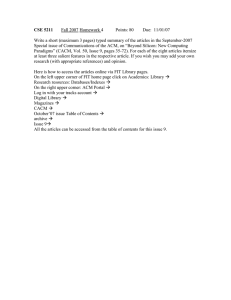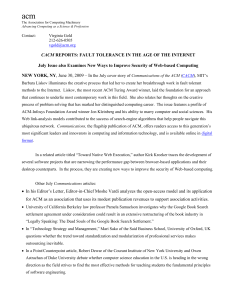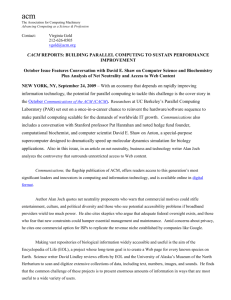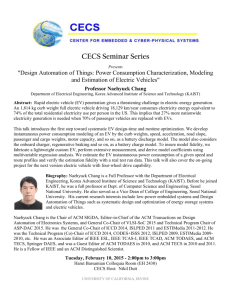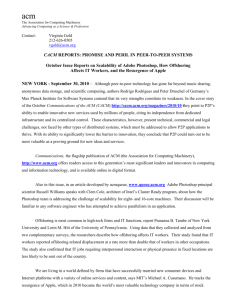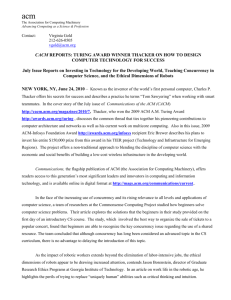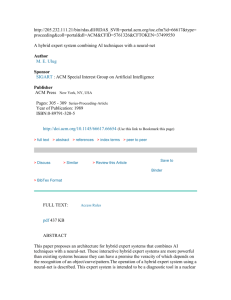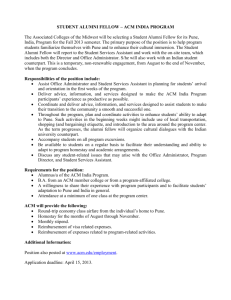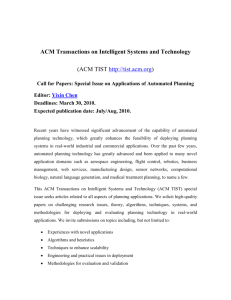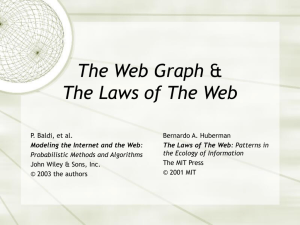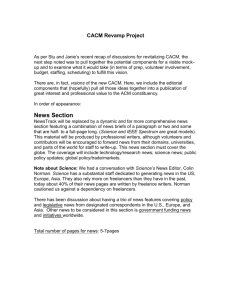to get the file
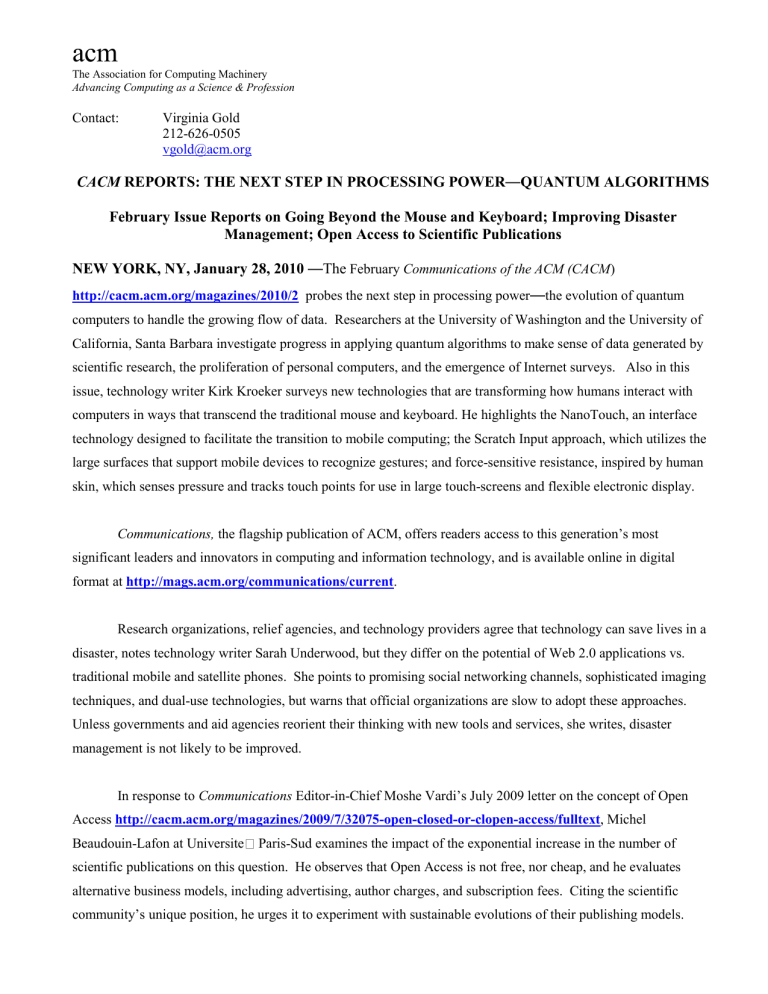
acm
The Association for Computing Machinery
Advancing Computing as a Science & Profession
Contact: Virginia Gold
212-626-0505 vgold@acm.org
CACM REPORTS: THE NEXT STEP IN PROCESSING POWER
—
QUANTUM ALGORITHMS
February Issue Reports on Going Beyond the Mouse and Keyboard; Improving Disaster
Management; Open Access to Scientific Publications
NEW YORK, NY, January 28, 2010
—
The February Communications of the ACM (CACM ) http://cacm.acm.org/magazines/2010/2 probes the next step in processing power
— the evolution of quantum computers to handle the growing flow of data. Researchers at the University of Washington and the University of
California, Santa Barbara investigate progress in applying quantum algorithms to make sense of data generated by scientific research, the proliferation of personal computers, and the emergence of Internet surveys. Also in this issue, technology writer Kirk Kroeker surveys new technologies that are transforming how humans interact with computers in ways that transcend the traditional mouse and keyboard. He highlights the NanoTouch, an interface technology designed to facilitate the transition to mobile computing; the Scratch Input approach, which utilizes the large surfaces that support mobile devices to recognize gestures; and force-sensitive resistance, inspired by human skin, which senses pressure and tracks touch points for use in large touch-screens and flexible electronic display.
Communications, the flagship publication of ACM, offers readers access to this generation’s most significant leaders and innovators in computing and information technology, and is available online in digital format at http://mags.acm.org/communications/current .
Research organizations, relief agencies, and technology providers agree that technology can save lives in a disaster, notes technology writer Sarah Underwood, but they differ on the potential of Web 2.0 applications vs. traditional mobile and satellite phones. She points to promising social networking channels, sophisticated imaging techniques, and dual-use technologies, but warns that official organizations are slow to adopt these approaches.
Unless governments and aid agencies reorient their thinking with new tools and services, she writes, disaster management is not likely to be improved.
In response to Communications Editor-in-Chief Moshe Vardi’s July 2009 letter on the concept of Open
Access http://cacm.acm.org/magazines/2009/7/32075-open-closed-or-clopen-access/fulltext , Michel
Beaudouin-Lafon at Universite Paris-Sud examines the impact of the exponential increase in the number of scientific publications on this question. He observes that Open Access is not free, nor cheap, and he evaluates alternative business models, including advertising, author charges, and subscription fees. Citing the scientific community’s unique position, he urges it to experiment with sustainable evolutions of their publishing models.
U.S. Department of Homeland Security Program Manager Douglas Maughan assesses the need for future generations of technology to better protect critical infrastructures and respond to attacks from adversaries. He encourages reenergized partnerships with both the educational systems and the private sector to overcome the shortfalls in cyberspace workers and the inadequate deployment of R&D results across the global infrastructure.
He also challenges federal networks and the IT research community to address underinvestment in critical R&D areas within both the government and private R&D communities.
Other February Communications articles:
Innovations in the field of type theory are moving beyond the realm of data structure and into more complex domains like security and networking. Information architect and writer Alex Wright surveys recent developments that are beginning to shape the way researchers think about program abstractions at a deep level.
University College London researcher M. Angela Sasse asserts that despite the conventional wisdom that remote surveillance cameras are a huge success story, new doubts have been raised over their benefits. She ponders why it is difficult
— but essential
— to monitor the effectiveness of security technologies.
Computing is no longer owned solely by computer science, according to Dennis P. Groth of Indiana University and Jeffrey K. MacKie-Mason of the University of Michigan. They note that computing and computational thinking have become ubiquitous, and are now embedded in all aspects of science, research, industry, government, and social interaction. They also probe how computing education needs to change to respond to the diverse applications demanded by increasingly complex societal problems.
In an article on formal methods for safety- and security-critical systems, engineers Steven P. Miller and Darren
D. Cofer of Rockwell Collins and Michael W. Whalen of the University of Minnesota discuss two important trends that are making the use of these methods applicable for widespread industrial applications in software or systems engineering.
Eric Benhamou, Jon Eisenberg, and Randy H. Katz, members of a committee established by the U.S. National
Academy of Sciences, summarize the findings and recommendations for what the U.S. government should do to help maintain American IT leadership.
Guest blogger Valerie Barr of Union College writes at BLOG@CACM
http://cacm.acm.org/blogs/blogcacm
about highlights of last fall’s Grace Hopper Celebration of Women in Computing Conference, including keynote speeches by Google’s Megan Smith and Rensselaer Polytechnic Institute’s Francine Berman.
For more information on Communications of the ACM , click on http://cacm.acm.org/
About ACM
ACM, the Association for Computing Machinery www.acm.org
, is the world’s largest educational and scientific computing society, uniting computing educators, researchers and professionals to inspire dialogue, share resources and address the field’s challenges. ACM strengthens the computing profession’s collective voice through strong leadership, promotion of the highest standards, and recognition of technical excellence. ACM supports the professional growth of its members by providing opportunities for life-long learning, career development, and professional networking.
# # #
